Long Ye
EnvSSLAM-FFN: Lightweight Layer-Fused System for ESDD 2026 Challenge
Dec 23, 2025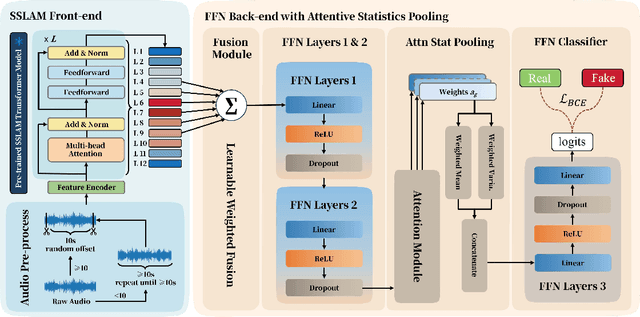
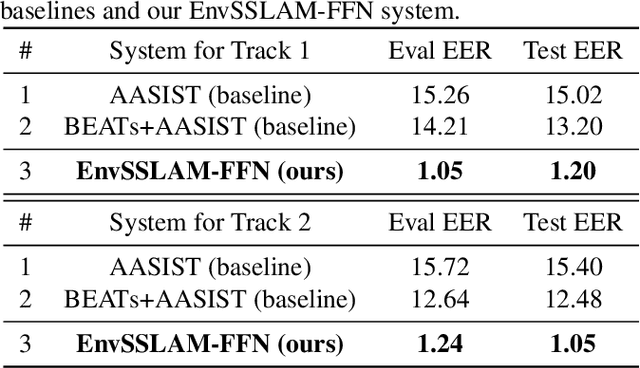
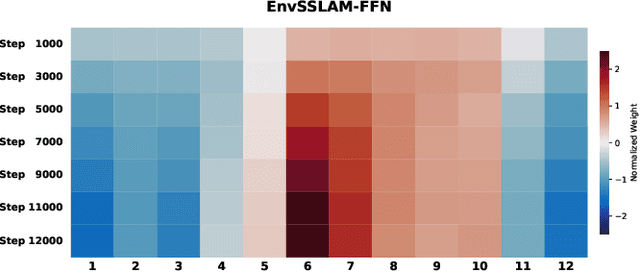
Abstract:Recent advances in generative audio models have enabled high-fidelity environmental sound synthesis, raising serious concerns for audio security. The ESDD 2026 Challenge therefore addresses environmental sound deepfake detection under unseen generators (Track 1) and black-box low-resource detection (Track 2) conditions. We propose EnvSSLAM-FFN, which integrates a frozen SSLAM self-supervised encoder with a lightweight FFN back-end. To effectively capture spoofing artifacts under severe data imbalance, we fuse intermediate SSLAM representations from layers 4-9 and adopt a class-weighted training objective. Experimental results show that the proposed system consistently outperforms the official baselines on both tracks, achieving Test Equal Error Rates (EERs) of 1.20% and 1.05%, respectively.
Depth-Guided Bundle Sampling for Efficient Generalizable Neural Radiance Field Reconstruction
May 26, 2025Abstract:Recent advancements in generalizable novel view synthesis have achieved impressive quality through interpolation between nearby views. However, rendering high-resolution images remains computationally intensive due to the need for dense sampling of all rays. Recognizing that natural scenes are typically piecewise smooth and sampling all rays is often redundant, we propose a novel depth-guided bundle sampling strategy to accelerate rendering. By grouping adjacent rays into a bundle and sampling them collectively, a shared representation is generated for decoding all rays within the bundle. To further optimize efficiency, our adaptive sampling strategy dynamically allocates samples based on depth confidence, concentrating more samples in complex regions while reducing them in smoother areas. When applied to ENeRF, our method achieves up to a 1.27 dB PSNR improvement and a 47% increase in FPS on the DTU dataset. Extensive experiments on synthetic and real-world datasets demonstrate state-of-the-art rendering quality and up to 2x faster rendering compared to existing generalizable methods. Code is available at https://github.com/KLMAV-CUC/GDB-NeRF.
GoLF-NRT: Integrating Global Context and Local Geometry for Few-Shot View Synthesis
May 26, 2025Abstract:Neural Radiance Fields (NeRF) have transformed novel view synthesis by modeling scene-specific volumetric representations directly from images. While generalizable NeRF models can generate novel views across unknown scenes by learning latent ray representations, their performance heavily depends on a large number of multi-view observations. However, with limited input views, these methods experience significant degradation in rendering quality. To address this limitation, we propose GoLF-NRT: a Global and Local feature Fusion-based Neural Rendering Transformer. GoLF-NRT enhances generalizable neural rendering from few input views by leveraging a 3D transformer with efficient sparse attention to capture global scene context. In parallel, it integrates local geometric features extracted along the epipolar line, enabling high-quality scene reconstruction from as few as 1 to 3 input views. Furthermore, we introduce an adaptive sampling strategy based on attention weights and kernel regression, improving the accuracy of transformer-based neural rendering. Extensive experiments on public datasets show that GoLF-NRT achieves state-of-the-art performance across varying numbers of input views, highlighting the effectiveness and superiority of our approach. Code is available at https://github.com/KLMAV-CUC/GoLF-NRT.
Detect All-Type Deepfake Audio: Wavelet Prompt Tuning for Enhanced Auditory Perception
Apr 09, 2025



Abstract:The rapid advancement of audio generation technologies has escalated the risks of malicious deepfake audio across speech, sound, singing voice, and music, threatening multimedia security and trust. While existing countermeasures (CMs) perform well in single-type audio deepfake detection (ADD), their performance declines in cross-type scenarios. This paper is dedicated to studying the alltype ADD task. We are the first to comprehensively establish an all-type ADD benchmark to evaluate current CMs, incorporating cross-type deepfake detection across speech, sound, singing voice, and music. Then, we introduce the prompt tuning self-supervised learning (PT-SSL) training paradigm, which optimizes SSL frontend by learning specialized prompt tokens for ADD, requiring 458x fewer trainable parameters than fine-tuning (FT). Considering the auditory perception of different audio types,we propose the wavelet prompt tuning (WPT)-SSL method to capture type-invariant auditory deepfake information from the frequency domain without requiring additional training parameters, thereby enhancing performance over FT in the all-type ADD task. To achieve an universally CM, we utilize all types of deepfake audio for co-training. Experimental results demonstrate that WPT-XLSR-AASIST achieved the best performance, with an average EER of 3.58% across all evaluation sets. The code is available online.
MAG: Multi-Modal Aligned Autoregressive Co-Speech Gesture Generation without Vector Quantization
Mar 18, 2025Abstract:This work focuses on full-body co-speech gesture generation. Existing methods typically employ an autoregressive model accompanied by vector-quantized tokens for gesture generation, which results in information loss and compromises the realism of the generated gestures. To address this, inspired by the natural continuity of real-world human motion, we propose MAG, a novel multi-modal aligned framework for high-quality and diverse co-speech gesture synthesis without relying on discrete tokenization. Specifically, (1) we introduce a motion-text-audio-aligned variational autoencoder (MTA-VAE), which leverages pre-trained WavCaps' text and audio embeddings to enhance both semantic and rhythmic alignment with motion, ultimately producing more realistic gestures. (2) Building on this, we propose a multimodal masked autoregressive model (MMAG) that enables autoregressive modeling in continuous motion embeddings through diffusion without vector quantization. To further ensure multi-modal consistency, MMAG incorporates a hybrid granularity audio-text fusion block, which serves as conditioning for diffusion process. Extensive experiments on two benchmark datasets demonstrate that MAG achieves stateof-the-art performance both quantitatively and qualitatively, producing highly realistic and diverse co-speech gestures.The code will be released to facilitate future research.
Neural Codec Source Tracing: Toward Comprehensive Attribution in Open-Set Condition
Jan 11, 2025



Abstract:Current research in audio deepfake detection is gradually transitioning from binary classification to multi-class tasks, referred as audio deepfake source tracing task. However, existing studies on source tracing consider only closed-set scenarios and have not considered the challenges posed by open-set conditions. In this paper, we define the Neural Codec Source Tracing (NCST) task, which is capable of performing open-set neural codec classification and interpretable ALM detection. Specifically, we constructed the ST-Codecfake dataset for the NCST task, which includes bilingual audio samples generated by 11 state-of-the-art neural codec methods and ALM-based out-ofdistribution (OOD) test samples. Furthermore, we establish a comprehensive source tracing benchmark to assess NCST models in open-set conditions. The experimental results reveal that although the NCST models perform well in in-distribution (ID) classification and OOD detection, they lack robustness in classifying unseen real audio. The ST-codecfake dataset and code are available.
Does Current Deepfake Audio Detection Model Effectively Detect ALM-based Deepfake Audio?
Aug 20, 2024

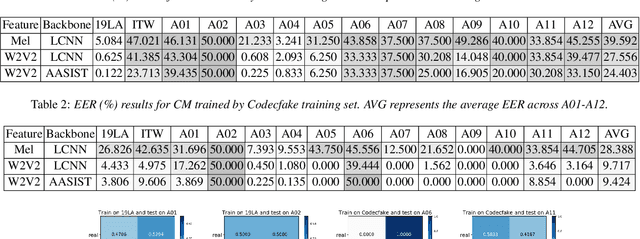

Abstract:Currently, Audio Language Models (ALMs) are rapidly advancing due to the developments in large language models and audio neural codecs. These ALMs have significantly lowered the barrier to creating deepfake audio, generating highly realistic and diverse types of deepfake audio, which pose severe threats to society. Consequently, effective audio deepfake detection technologies to detect ALM-based audio have become increasingly critical. This paper investigate the effectiveness of current countermeasure (CM) against ALM-based audio. Specifically, we collect 12 types of the latest ALM-based deepfake audio and utilizing the latest CMs to evaluate. Our findings reveal that the latest codec-trained CM can effectively detect ALM-based audio, achieving 0% equal error rate under most ALM test conditions, which exceeded our expectations. This indicates promising directions for future research in ALM-based deepfake audio detection.
Temporal Variability and Multi-Viewed Self-Supervised Representations to Tackle the ASVspoof5 Deepfake Challenge
Aug 13, 2024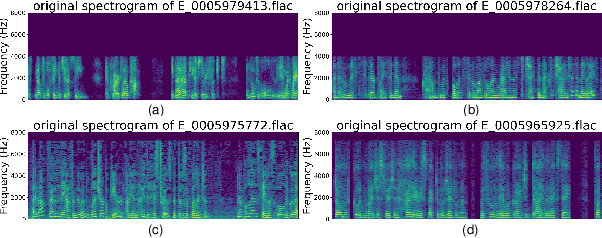
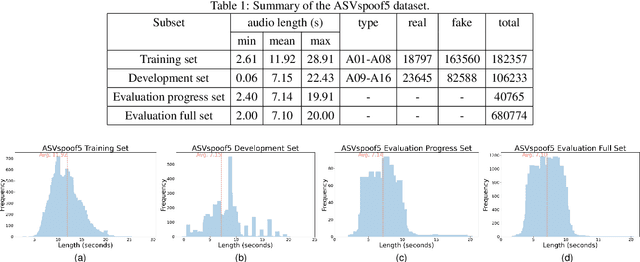
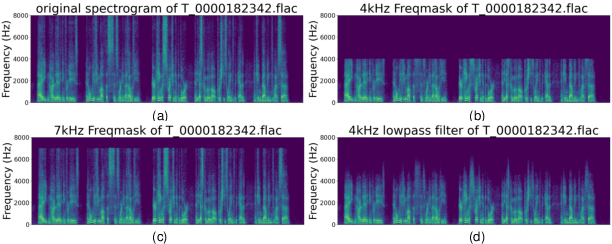
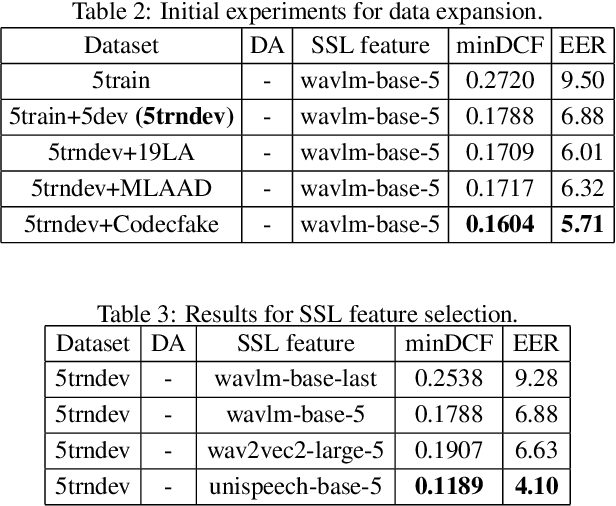
Abstract:ASVspoof5, the fifth edition of the ASVspoof series, is one of the largest global audio security challenges. It aims to advance the development of countermeasure (CM) to discriminate bonafide and spoofed speech utterances. In this paper, we focus on addressing the problem of open-domain audio deepfake detection, which corresponds directly to the ASVspoof5 Track1 open condition. At first, we comprehensively investigate various CM on ASVspoof5, including data expansion, data augmentation, and self-supervised learning (SSL) features. Due to the high-frequency gaps characteristic of the ASVspoof5 dataset, we introduce Frequency Mask, a data augmentation method that masks specific frequency bands to improve CM robustness. Combining various scale of temporal information with multiple SSL features, our experiments achieved a minDCF of 0.0158 and an EER of 0.55% on the ASVspoof 5 Track 1 evaluation progress set.
Generalized Source Tracing: Detecting Novel Audio Deepfake Algorithm with Real Emphasis and Fake Dispersion strategy
Jun 05, 2024Abstract:With the proliferation of deepfake audio, there is an urgent need to investigate their attribution. Current source tracing methods can effectively distinguish in-distribution (ID) categories. However, the rapid evolution of deepfake algorithms poses a critical challenge in the accurate identification of out-of-distribution (OOD) novel deepfake algorithms. In this paper, we propose Real Emphasis and Fake Dispersion (REFD) strategy for audio deepfake algorithm recognition, demonstrating its effectiveness in discriminating ID samples while identifying OOD samples. For effective OOD detection, we first explore current post-hoc OOD methods and propose NSD, a novel OOD approach in identifying novel deepfake algorithms through the similarity consideration of both feature and logits scores. REFD achieves 86.83% F1-score as a single system in Audio Deepfake Detection Challenge 2023 Track3, showcasing its state-of-the-art performance.
The Codecfake Dataset and Countermeasures for the Universally Detection of Deepfake Audio
May 08, 2024



Abstract:With the proliferation of Audio Language Model (ALM) based deepfake audio, there is an urgent need for effective detection methods. Unlike traditional deepfake audio generation, which often involves multi-step processes culminating in vocoder usage, ALM directly utilizes neural codec methods to decode discrete codes into audio. Moreover, driven by large-scale data, ALMs exhibit remarkable robustness and versatility, posing a significant challenge to current audio deepfake detection (ADD) models. To effectively detect ALM-based deepfake audio, we focus on the mechanism of the ALM-based audio generation method, the conversion from neural codec to waveform. We initially construct the Codecfake dataset, an open-source large-scale dataset, including two languages, millions of audio samples, and various test conditions, tailored for ALM-based audio detection. Additionally, to achieve universal detection of deepfake audio and tackle domain ascent bias issue of original SAM, we propose the CSAM strategy to learn a domain balanced and generalized minima. Experiment results demonstrate that co-training on Codecfake dataset and vocoded dataset with CSAM strategy yield the lowest average Equal Error Rate (EER) of 0.616% across all test conditions compared to baseline models.
 Add to Chrome
Add to Chrome Add to Firefox
Add to Firefox Add to Edge
Add to Edge